Sector-specific Cash and Voucher Assistance
CVA can help people in crises address their needs within a specific humanitarian sector, such as water, food, health, shelter, livelihood, or protection. Sector-specific CVA can be restricted or unrestricted, and conditional or unconditional, and will typically be provided as part of a comprehensive package which may also include in-kind and service-based assistance.
Each sector has to consider different questions, challenges, advantages and risks when it comes to supporting people’s recovery within their area of expertise. This requires evidence, tools, guidance and capacity. Meeting sector-specific outcomes through CVA also requires a multi-sectoral understanding of needs and of household economic security – see Multipurpose Cash Assistance. While some sectors are very experienced in implementing CVA and have done so for many years, others are now catching up. Most humanitarian sectors are committed and have been increasing their efforts on sector-specific CVA. The Global Cluster Coordination Group (GCCG) is also coordinating cross-cluster work to improve the sectoral used of CVA.
Current priorities
The CALP Network works closely with the cash technical groups/task teams within the global clusters, who have been defining their 2020 priorities and workplans during their regular meetings. A general overview and specific details of these priorities across each global cluster is available here.
Sector-specific CVA subpages
Camp Coordination, Camp Management and Cash and Voucher Assistance
Page
Find out more about Camp Coordination and Camp Management (CCCM) in relation to Cash and Voucher Assistance (CVA). For the most up to date information visit the Global CCCM Cluster’s website.
Education and Cash and Voucher Assistance
Page
A brief introduction as to how Cash and Voucher Assistance (CVA) can support education outcomes. For the most up to date information please visit the Global Education Cluster’s website.
Food Security and Cash and Voucher Assistance
Page
A brief introduction as to how Cash and Voucher Assistance (CVA) can support food security outcomes. For the most up to date information please visit the Food Security Cluster Cash and Market Working Group web page.
Health and Cash and Voucher Assistance
Page
The content on this webpage has been developed with the Global Health Cluster.
Nutrition and Cash and Voucher Assistance
Page
Malnutrition continues to pose a major challenge to human well-being around the world. In 2020, an estimated 144 million children under five suffer from stunting (i.e. chronic malnutrition) , 47 million children under five were wasted (i.e. acute malnutrition) , of which 14.3 million were severely wasted, and an additional 340 million suffered from micronutrient deficiencies (UNICEF/WHO/WB...
Protection and Cash and Voucher Assistance
Page
How can Cash and Voucher Assistance (CVA) support protection outcomes? Please find a brief summary below, and for the very latest information, refer to the Global Protection Cluster Task Team on Cash for Protection.
Shelter and Cash and Voucher Assistance
Page
How can Cash and Voucher Assistance (CVA) support shelter outcomes? Please find a brief summary below, and for the very latest information, refer to the Shelter and Cash Working Group.
WASH and Cash and Voucher Assistance
Page
How can Cash and Voucher Assistance (CVA) support WASH outcomes? Please find a brief summary below, and for the very latest information, refer to the WASH Cluster’s Cash and Markets Technical Working Group.
Latest

Cash Enthusiast’s Guide to Humanitarian Networks and Partnerships Week
Blog Post
The fifth Humanitarian Networks and Partnerships Week (HNPW) will be held at the International Conference Centre (CICG) in Geneva, Switzerland from 4-8 February 2019.
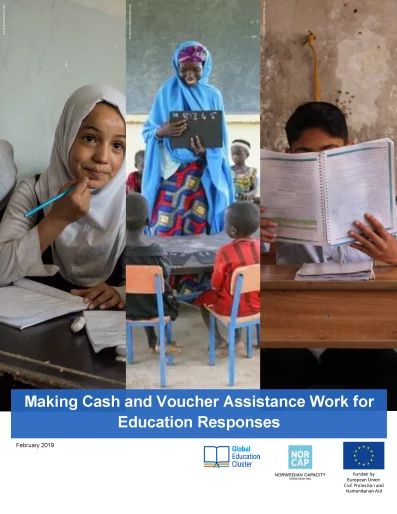
Making Cash and Voucher Assistance Work for Education Responses
Report
While the body of knowledge on general cash and voucher assistance (CVA) practices has grown, there is a significant knowledge gap for the use of CVA for EiE. Furthermore, CVA is typically led by cash experts within humanitarian organizations and social protection branches of governments, and education...

Building Evidence to inform the Effective Use of CASH and Voucher Assistance in Emergency Sanitation and Hygiene Programming
Report
An analysis of 5 case studies of utilization of CASH/Voucher Assistance are presented and analysed in the attempt of building evidence on their utilization in emergency WASH Sanitation and HP programming. Findings and recommendations are provided on Coordination, Situation and Response Analysis, Program...
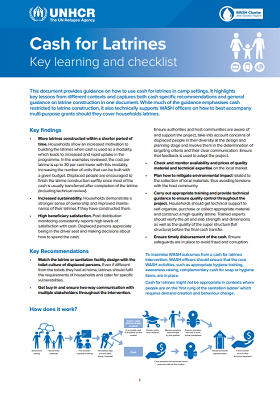
Cash for Latrines
Guidelines and Tools
This document provides guidance on how to use cash for latrines in camp settings. It highlights key lessons from different contexts and captures both cash specific recommendations and general guidance on latrine construction in one document.
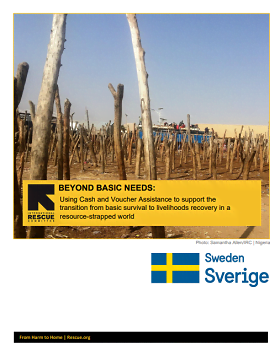
Beyond Basic Needs: Using Cash and Voucher Assistance to Support the Transition from Basic Survival to Livelihoods Recovery in a Resource-Strapped World
Guidelines and Tools
Do you think of yourself as a “cash” person OR as a “livelihoods” person? An “emergency” practitioner OR a “recovery” practitioner? Or do you find yourself unsatisfied with the often narrow implications of these terms? We’ll never have enough funding to provide basic needs support to...

CVA for Protection: A Mapping of IRC’s Use of Cash and Voucher Assistance to Help Achieve Protection Outcomes
Guidelines and Tools
The IRC first began to integrate cash into protection programs in 2013, leveraging the flexibility of CVA to support clients living in urban refugee contexts in the Middle East. Since then, IRC has rapidly expanded its use of CVA to help achieve protection outcomes. This scale-up has come with important...

Reflections and recommendations from evaluations of the 2017 CVA Somalia Drought Response
Report
Improving our response to drought to avert crises through the use of cash and voucher assistance requires us to build on experience. This paper pulls together reflections and recommendations from a review of eight evaluation reports, reviews and studies that were conducted during or after the 2017 drought...

Can cash transfers in humanitarian contexts help prevent, mitigate, and respond to gender-based violence? A review of the evidence
Report
Today, approximately 10 percent of humanitarian assistance globally is delivered via cash transfer programming (CTP) and cash is increasingly being scaled across the humanitarian system. Yet the use of cash within the protection sector trails behind the use of cash in all other sectors. Refugee and...

Introductory Research on the Feasibility of Cash and Voucher Assistance in Rural Fiji
Report
This report presents the findings of a study into the general feasibility of using Cash and Voucher Assistance (CVA) in responding to disasters in Fiji. The term “Cash and Voucher Assistance” or CVA, is used in the report in line with the the CALP Network definition, so it refers to programs where...

Guide to Cash and Voucher Assistance and Gender-based Violence Resources
Guidelines and Tools
This one-page guide helps practitioners understand how three complementary resources support the integration of CVA and GBV prevention, mitigation and response to strengthen humanitarian response. It aims to help users make decisions on when to use each resource at different stages of work and compares:

Cash transfer Programmes – Impact on Stunting and Financial Inclusion
Report
This report focussed on evidence published in the last ten years (since 2009) on cash transfer programs’ impact on stunting and financial inclusion. The importance of maternal education on stunting emerged from the literature and warrants further investigation, which was outside the scope of this...

Kızılaykart Cash Based Assistance, Information Note
Report
Following the first refugee wave in May 2011, refugees from Syria has continued to seek asylum in Turkey. As a result of the open-door policy between 2011 and 2015, Syrians were welcomed by the Turkish government and obtained legal status under temporary protection. Subsequently, Turkey is hosting more...
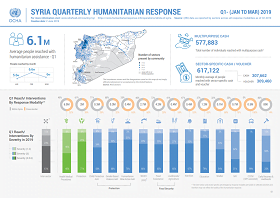
Syria Quarterly Humanitarian Response (Q1 January to March 2019)
Report
Summary of the humanitarian aid delivered to beneficiaries in Syria during Q1 2019

Cash and Voucher Assistance for Education in Emergencies. Synthesis Report and Guidelines
Report
The Global Education Cluster (GEC) developed in 2018-19 the Synthesis and Guidelines on Cash and Voucher Assistance for Education in Emergencies (EiE). The document was developed with financial support from ECHO and technical support from CashCap. The research focused on current CVA practices for...
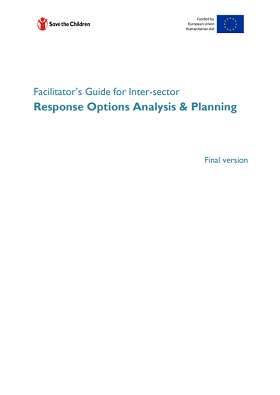
Response Options Analysis Planning Guide
Guidelines and Tools
The inter-sector Response Options Analysis and Planning (ROAP) is a structured decision-making process, which draws from the information generated through a multitude of needs and operational environment assessments. The ROAP gives way to the selection of the most appropriate, operationally feasible and...

Cash for Shelter in Kenya – A Field Experience
Report
A study of a cash for shelter project in Kalobeyei that highlights how UNHCR uses cash assistance to help the refugees to transition to more durable solutions, in this case, integration with the host community. The project presents a paradigm shift from the traditional refugee camp planning process.

Elevating Education in Emergencies
Report
The overall purpose of the Elevating Education in Emergencies series is to galvanise increased attention for and prioritisation of education in humanitarian responses. Following the first session which explored education’s critical role in bringing protection to children, youth and
communities affected...

Protecting Nutrition of Pregnant and Lactating Women and Children in Acute Food Crises
Report
This briefing sheet provides an overview of methods and findings from a study examing the impact of cash and voucher assistance on prevention of acute malnutrition among pregnant and lactating women and children in the context of the 2017/18 Somalia food crisis. Changes in diet and acute malnutrition were...
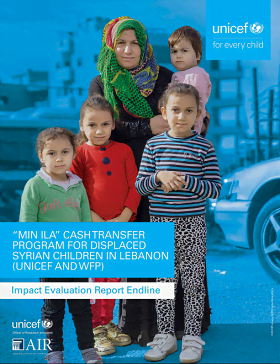
“Min Ila” cash transfer program for displaced Syrian children in Lebanon
Report
“Min Ila” is a cash transfer program that was implemented by UNICEF and the United Nation’s World Food Program (WFP) in coordination with the Ministry of Education and Higher Education (MEHE), between 2016 and 2018 covering two (and later three) Lebanese governorates. The program, also known as...

Micro-level changes in market recovery and growth: The Ebola CTP experience
Webinar recording
Following our Ebola dissemination event in Dakar, the CALP Network hosted a webinar looking at the micro level effects of cash transfers on local economies during the Ebola crisis. Listen to the recording here.


